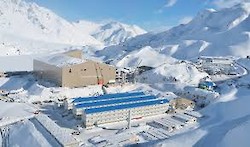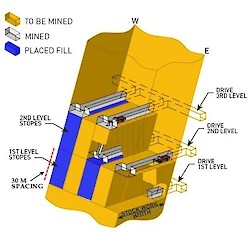Brucejack Mine
Commodities: Gold (Au) and silver (Ag)
Location: 65 kilometers north of Stewart, accessed by 74 km gravel access road from Hwy 37.
Geology and Type of Deposit: Brucejack Gold Mine is remote, located at 1300m above the tree line in the Boundary Range of the Intermontane Belt of the Canadian Cordillera. Known as the Valley of the Kings deposit, gold and silver occur together as the alloy, electrum. The electrum occurs in stock work quartz-carbonate veins that are centralized on the axis of a broad fold in Late Triassic-Early Jurassic volcanic and sedimentary rocks. Pyrite, sphalerite, galena, chalcopyrite, and pyargerite also occur in the veins. The ore body ranges from 20-50m thick.
 The Operation: Mineralization was first discovered in the region in the 1930s, but targeted exploration began in earnest in the 1960s. In 2009-2010 Silver Standard Resources drilled tens of thousands of metres to outline the Valley of the Kings deposit. The property was acquired by Pretium Resources in 2010 who continued surface exploration and targeted drilling; underground development began in 2012. With geological data from 932 drill holes totalling more than 218,000 metres, permitted construction of the mine began in late 2015. It was completed in mid-2017, including a 57 kilometer-long transmission line to the mine. The cost to build and equip was $881 million.
The Operation: Mineralization was first discovered in the region in the 1930s, but targeted exploration began in earnest in the 1960s. In 2009-2010 Silver Standard Resources drilled tens of thousands of metres to outline the Valley of the Kings deposit. The property was acquired by Pretium Resources in 2010 who continued surface exploration and targeted drilling; underground development began in 2012. With geological data from 932 drill holes totalling more than 218,000 metres, permitted construction of the mine began in late 2015. It was completed in mid-2017, including a 57 kilometer-long transmission line to the mine. The cost to build and equip was $881 million.
In November 2021 Newcrest agreed to acquire Pretium Resources Inc., including 100% of the Brucejack operation. The mine is permitted to extract 3,800 tonnes per day. That's approximately equal to the weight of 540 elephants! In June 2017 it produced its first gold pour. Based on expected rates of production and the current proven and probable reserves, mining will continue until 2035.
 Mining Method: Brucejack Gold Mine is an underground mine. The method used to extract the ore is long hole stoping. The ore body is accessed by a main decline from a surface portal (entrance) near the concentrator (mill). The orebody is reached by drilling using jumbos and blasting that create tunnels to intersect the ore body at different depths. The ore is mined by drilling and blasting to create a stope (void )with a ceiling that raises as mining continues; blasted ore (muck) falls to the tunnel floor. Electric load haul dumps (LHDs) and mine trucks haul the muck to a primary jaw crusher where it is crushed to smaller pieces that are dropped down onto a belt and conveyed up to the surface, directly into the concentrator.
Mining Method: Brucejack Gold Mine is an underground mine. The method used to extract the ore is long hole stoping. The ore body is accessed by a main decline from a surface portal (entrance) near the concentrator (mill). The orebody is reached by drilling using jumbos and blasting that create tunnels to intersect the ore body at different depths. The ore is mined by drilling and blasting to create a stope (void )with a ceiling that raises as mining continues; blasted ore (muck) falls to the tunnel floor. Electric load haul dumps (LHDs) and mine trucks haul the muck to a primary jaw crusher where it is crushed to smaller pieces that are dropped down onto a belt and conveyed up to the surface, directly into the concentrator.
Mineral Processing: At the surface the crushed ore is conveyed into the concentrator, entering first a SAG mill, then a ball mill that pulverizes the ore to sand. The slurry passes through a gravity circuit that separates out the coarse gold/silver electrum and sends it directly to a shaker table. The electrum is then melted and poured to form a doré bar.
From the gravity circuit the slurry passes through flotation cells in which the ore mineral concentrate is separated from the tailings. The concentrate is piped to a thickener cell and through a press to reduce the water. It is then bagged and stored for shipping.
Tailings from the flotation circuits also go to a thickener to reduce water. Half the tailings will be directed to a paste plant to create a concrete-like material that is used to back fill mined-out stopes. The rest will be piped to and stored under water in Brucejack Lake, which is not fish bearing.
Markets: When in full production bagged concentrate from Brucejack Gold Mine will be trucked to Terrace, then loaded into rail cars and shipped to a smelter in Quebec.
Community and Employment: At full production Brucejack will employ up to 550 people, half on site at any given time. Employees at the mine come from nearby communities and from long distance. All live in permanent camp dormitories at the mine while on shift where all meals are provided as are most of the comforts of home.
Environmental Considerations: Located in the alpine above tree line, the mine site area includes barren rock outcrops, moss and shrubs and sparse trees, and small wetlands. The area had largely not been disturbed by humans and is home to many animals, including bears, mountain goats, moose, bats, small mammals, birds, reptiles and amphibians. They include some species at risk: wolverine, fisher, grizzly bear, western toad, barn swallow, rusty blackbird, olive sided fly catcher, and little brown bat, as well as species that are important to hunting/trapping in the region: moose, mountain goat, black bear, American marten, harlequin duck, and trumpeter swan. Surveys have been done to document numbers and distribution of wildlife and the habitats for important species have been mapped.
The operators aim to impact the area and wildlife as little as possible during operation. When the mine closes the goal will be to return disturbed areas to a level of productivity as good or better than it was before mining. For more information on the mine, visit Newcrest Mining.
BCMEM's Valley of the Kings MINFILE profile.
